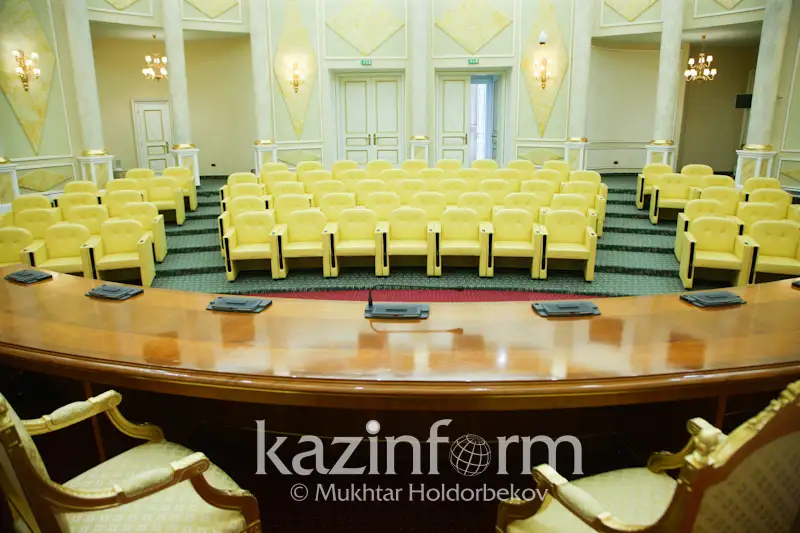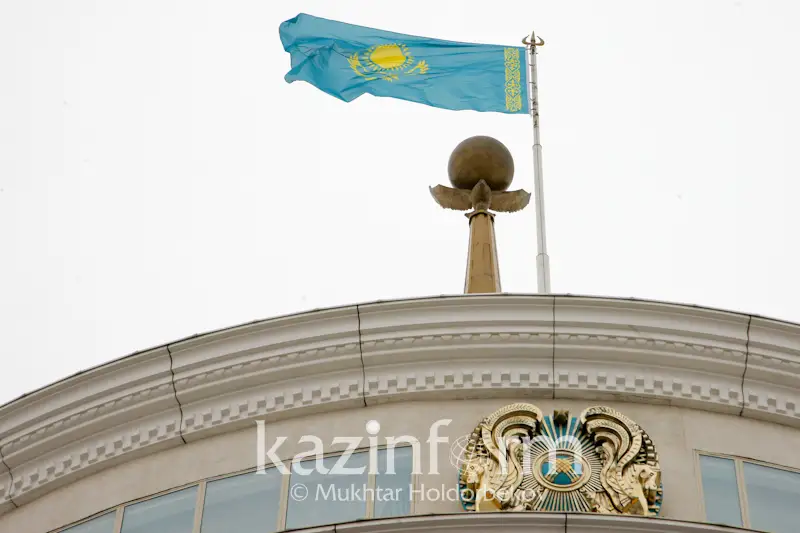Akorda - what we need to know about Kazakhstan's main building

Akorda is not only the main building of the country but also a key element constituting the main architectural composition of the capital's left bank. What is more, a team of top Kazakh and foreign architects was developing the basic concept of the building.
Experts from 10 countries worked on the major building of the country. In fact, Akorda is a big palace that combines traditional Kazakh, Oriental and European motifs.
All visitors of Akorda meet at the Grand Central Hall located on the first floor. Its dimensions are impressive - the area of the hall is 1,800 square meters. It is intended for state receptions with an honor guard. In the center of the hall, there is a large dome with a crystal chandelier.
In total, there are about 40 chandeliers, including the main one hanging in the middle, which brightly illuminate the huge hall and instill a particular sense of solemnity to receptions.
The remarkable thing is that the basic chandelier of the hall is hanging not from the ceiling of the first floor but from the second one through a large circular hole.
According to the local staff, that chandelier is so large that an electrician is required to enter inside it in order to replace its lamps.
Behind numerous marble columns, the hall walls are decorated with shanyraks (yurt crowns).
In addition, on the first floor of Akorda, there is the Gala Hall for state receptions of the President of the Republic of Kazakhstan, the Hall of Press Conferences, and the Winter Garden.
The Gala Hall is decorated in the style of old-time halls, adding a great solemnity to the occasions that it hosts. Along the perimeter of the hall, there are spiral-shaped columns built into the walls. The room is brightly illuminated by the crystal chandeliers and wall-mounted lighting fixtures.
 The receptions taking place in the Gala Hall are accompanied by live music, as evidenced by the lodges and piano for the orchestra.
The receptions taking place in the Gala Hall are accompanied by live music, as evidenced by the lodges and piano for the orchestra.
The floor here was made of marble decorated with embossed flowers and ethnic patterns. Behind the marble platform, and in the far corners of the hall, there are wooden models of Kazakh national instruments.
Not every journalist is honored to cover events in Akorda. Therefore, it is necessary to mention the premises specially intended for meetings with media. To that end, all conditions have been created in the Hall to host press conferences and meetings with the Head of State.
First of all, it's a wonderful acoustics owing to the high domed ceiling. Besides, the hall is equipped with necessary audio equipment.
As compared to the other two above-mentioned premises of the ground floor, the Winter Garden does not look that impressive due to its small size.
 However, it was elegantly designed. In the Winter Garden, there are two green marble columns that serve as a special door or entrance. The ceiling of the garden itself is supported by four more milk-white square-shaped columns with concave corners. In the middle of the garden, there is a decorative marble fountain with small tables standing along its edges in among the green.
However, it was elegantly designed. In the Winter Garden, there are two green marble columns that serve as a special door or entrance. The ceiling of the garden itself is supported by four more milk-white square-shaped columns with concave corners. In the middle of the garden, there is a decorative marble fountain with small tables standing along its edges in among the green.
As a rule, high-level negotiations are held here, but in an informal format.
Two wide red-carpeted staircases of white marble lead to the second floor. There are offices of employees working here, so we suggest that going up a floor above.
 One of the main attractions of the third floor is the Oriental Hall, which was designed in the shape of a huge yurt.
One of the main attractions of the third floor is the Oriental Hall, which was designed in the shape of a huge yurt.
This hall differs from the other ones by its original style and high acoustics as a hard shoe step makes a loud sound, echoing repeatedly and getting absorbed by the high dome. There are no doors here, but there are a few oval entrances, therefore, visitors can go into one of them, go through, and get out via another one.
Instead of chairs, there are small Oriental-style sofas. The chandelier in this room seems to be small in size. However, owing to dozens of small bright lamps built into the dome, the illumination in the Oriental Hall is quite bright.
Not far from the Oriental Hall, there is the so-called Marble Hall, which is called so because of the material it was mainly made of.
Even a lot of soft chairs around a large oval table are of marble color as well as elements decorating the walls.
By the way, the walls are decorated not only with marble but also with large paintings.
Unlike the previous premise we have described, this hall has a more formal status. As a rule, it hosts documents signature ceremonies within official visits and summits with the participation of the President of the Republic of Kazakhstan and the heads of state and government of foreign countries. The Marble Hall also hosts presentations of credentials by ambassadors of foreign countries accredited in Kazakhstan, as well as the Republic of Kazakhstan state decorations and honorary titles award ceremonies.
The Golden Hall, located here, also boasts large paintings on the walls. Needless to say that all the elements here are golden-hued. The Golden Hall is smaller than the Marble Hall because it is intended for narrow-format negotiations and meetings between the President of the Republic of Kazakhstan and the heads of state and government of foreign countries. Here, the Head of State meets with foreign delegations, ambassadors of foreign countries accredited in the Republic of Kazakhstan.
In addition, on the third floor, there is the Oval Hall used for high-level negotiations between the delegations of the Republic of Kazakhstan and foreign countries, the Head of State's meetings and talks with foreign delegations, representatives of foreign businesses; the Guest Room (here the President receives foreign ambassadors after presenting credentials); the Hall of Extended Negotiations used for high-level negotiations between the delegations of the Republic of Kazakhstan and foreign countries; and the Security Council Hall that hosts meetings of the Security Council of the Republic of Kazakhstan.
One of the most remarkable premises of the fourth floor of the Akorda Presidential Palace is the Dome Hall, where the Heads of State's summit meetings, his meetings with representatives of the country's ministries and agencies, parties, movements and creative intelligentsia, and sessions of advisory bodies under the President of the Republic of Kazakhstan are held. The hall is round and has a domed ceiling. One of the hallmarks of the room is green marble columns: 14 pairs of columns of a darker shade make up the lower tier, while at the top there are light green columns supporting a set of decorative lancet arches. In the center of the wall, there is the National Emblem of the Republic of Kazakhstan. You can enter the hall through any of the four entrances.
Also, on the fourth floor, there is the Meeting Hall, the Negotiation Hall, and the Presidential Library that has a unique collection of books. The Meeting Hall is intended for meetings of the President of the Republic of Kazakhstan with the Government, heads of structural subdivisions of the President's Executive Office, the governors of the regions and the mayors of Astana and Almaty, heads of ministries and agencies, as well as the Head of State's meetings with representatives of business circles of the country. The Negotiation Hall is used for meetings and talks of the Head of the Kazakh President's Executive Office, Aide to the President with foreign delegations, ambassadors of foreign countries accredited in the Republic of Kazakhstan, representatives of foreign businesses.
I would like to add that Akorda is located on an artificial mound, therefore, it looks quite advantageous from various perspectives.
 This step became one of the key ideas of the European and Kazakh architects who worked on the building. As to the interior, it was academician Kaldybai Montakhayev who provided consultations. The construction of the official residence of President Nursultan Nazarbayev began in 2001. Akorda was officially unveiled in 3 years, in December 2004.
This step became one of the key ideas of the European and Kazakh architects who worked on the building. As to the interior, it was academician Kaldybai Montakhayev who provided consultations. The construction of the official residence of President Nursultan Nazarbayev began in 2001. Akorda was officially unveiled in 3 years, in December 2004.
The total area of the building is 36,500 square meters, its height from the tip of the spire to the foundation is 86 m.
 To construct it, the builders used monolithic concrete alongside state-of-the-art construction methods and advanced engineering equipment. The principal front faces a small square with a fountain and flower walks, which adds additional brilliance and solemnity to it.
To construct it, the builders used monolithic concrete alongside state-of-the-art construction methods and advanced engineering equipment. The principal front faces a small square with a fountain and flower walks, which adds additional brilliance and solemnity to it.
Special attention was given to the external landscaping of the composition. The square in front of Akorda accentuates the magnificence of the principal front of the Presidential Palace. The access roads and asphalt paths, small architectural forms, parking zones successfully fit the composition. The area is framed by a decorative illuminated fencing. Mostly white, blue and golden-colored, the building reflects the modern state style of Kazakhstan. This style was laid at the dawn of independence, and, owing to the main building of the country, obtained particular contours and recognizability all over the world.
 The material was prepared with the support from the Press Service of the President of the Republic of Kazakhstan.
The material was prepared with the support from the Press Service of the President of the Republic of Kazakhstan.